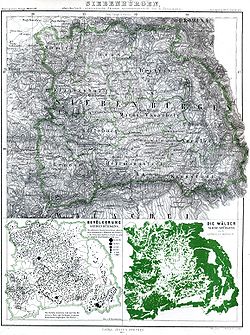Principality of Transylvania (1570–1711)
Transylvania | |||||||||
|---|---|---|---|---|---|---|---|---|---|
| 1571–1711 | |||||||||
 Map of the Great Principality of Transylvania (1857) | |||||||||
| Capital | Cluj-Napoca, Alba-Iulia | ||||||||
| Common languages | Romanian (official language from 1920), Hungarian, German (minorities' languages only) | ||||||||
| Government | Principality | ||||||||
| History | |||||||||
• Established | 1571 | ||||||||
• Disestablished | 1711 | ||||||||
| |||||||||
Insert non-formatted text hereThe Principality of Transylvania was a semi-independent state ruled by mostly Calvinist Hungarian princes. The Principality existed from 1571 to 1711.
| History of Hungary |
|---|
 |
|
|
| History of Austria |
|---|
 |
|
|
Transylvania as an independent principality
On 29 August 1526, the army of Sultan Suleiman of the Ottoman Empire inflicted a decisive defeat on the Hungarian forces at Mohács. János Szapolyai was en route to the battlefield with his sizable army but did not participate in the battle for unknown reasons. The youthful King Louis II of Hungary and Bohemia fell in battle, as did many of his soldiers. As Szapolyai was elected king of Hungary, Ferdinand from the House of Habsburg also claimed the throne of Hungary. In the ensuing struggle Szapolyai received the support of Sultan Suleiman I, who after his death in 1540 occupied Buda and central Hungary in 1541 under the pretext of protecting Zápolya's son, John II. Hungary was now divided into three sections: the West and north Royal Hungary, Ottoman Hungary, and the Eastern Hungarian Kingdom under Ottoman suzerainty, which later became the Principality of Transylvania where Austrian and Turkish influences vied for supremacy for nearly two centuries. The Hungarian magnates of Transylvania resorted to policy of duplicity in order to preserve independence.

Transylvania was now beyond the reach of Catholic religious authority, allowing Lutheran and Calvinist preaching to flourish. In 1563, Giorgio Blandrata was appointed as court physician, and his radical religious ideas increasingly influenced both the young king John II and the Calvinist bishop Francis David, eventually converting both to the Anti-Trinitarian (Unitarian) creed. In a formal public disputation, Francis David prevailed over the Calvinist Peter Melius; resulting in 1568 in the formal adoption of individual freedom of religious expression under the Edict of Turda (the first such legal guarantee of religious freedom in Christian Europe, however only for Lutherans, Calvinists, Unitarians and of course Catholics, with the Orthodox Christian confession being explicitly banned).
The Báthory family, which came to power on the death of John II in 1571, ruled Transylvania as princes under the Ottomans, and briefly under Habsburg suzerainty, until 1602. Their rise to power marked the beginning of the Principality of Transylvania as a semi-independent state.
The younger István Báthory, a Hungarian Catholic who later became King under the name Stephen Bathory of Poland, undertook to maintain the religious liberty granted by the Edict of Turda, but interpreted this obligation in an increasingly restricted sense. The latter period of Báthory rule saw Transylvania under Zsigmond Báthory enter the Long War, which started as a Christian alliance against the Turks and became a four-sided conflict in Transylvania involving the Transylvania, the Habsburgs, the Ottomans, and Wallachia.
Around 1601 the Principality for a short time was under the rule of Rudolf I who initiated the Germanization of the population, and in order to reclaim the Principality for Catholicism the Counter Reformation. From 1604-1606, the Hungarian nobleman István Bocskay led a successful rebellion against Austrian rule. Bocskay was elected Prince of Transylvania on 5 April 1603 and prince of Hungary two months later. He achieved the Piece of Vienna in 1606)(June 23, 1606). By the Peace of Vienna, Bocskay obtained religious liberty and political autonomy, the restoration of all confiscated estates, the repeal of all "unrighteous" judgments, and a complete retroactive amnesty for all Hungarians in Royal Hungary, as well as his own recognition as independent sovereign prince of an enlarged Principality of Transylvania.

Under Bocskay's successors Transylvania had its golden age, especially under the reigns of Gábor Bethlen and György I Rákóczi. Gábor Bethlen, who reigned from 1613 to 1629, perpetually thwarted all efforts of the emperor to oppress or circumvent his subjects, and won reputation abroad by championing the Protestant cause. Three times he waged war on the emperor, twice he was proclaimed King of Hungary, and by the Peace of Nikolsburg (December 31, 1621) he obtained for the Protestants a confirmation of the Treaty of Vienna, and for himself seven additional counties in northern Hungary. Bethlen's successor, George I Rákóczi, was equally successful. His principal achievement was the Peace of Linz (September 16, 1645), the last political triumph of Hungarian Protestantism, in which the emperor was forced to confirm again the articles of the Peace of Vienna. Gabriel Bethlen and George I Rákóczi also did much for education and culture, and their era has justly been called the golden era of Transylvania. They lavished money on the embellishment of their capital Gyulafehérvár, which became the main bulwark of Protestantism in Eastern Europe. During their reign Transylvania was also one of the few European countries where Roman Catholics, Calvinists, Lutherans, and Unitarians lived in mutual tolerance, all of them belonging to the officially accepted religions - religiones recaepte, while Orthodoxs, however, were only tolerated.
The fall of Várad (1660) marked the decline of the Principality of Transylvania which ended with the Habsburg monarchs gaining increased control of this territory. Under Prince Kemeny, the diet of Transylvania proclaimed the secession of Transylvania from the Ottomans (April 1661) and appealed for help to Vienna but a secret Habsburg-Ottoman agreement resulted in further increasing Habsburg influence.
See also:
List of rulers of Transylvania
External links
"HISTORY OF TRANSYLVANIA" http://ro.wikipedia.org/wiki/Istoria_Transilvaniei
- ^ "Transylvania". Encyclopædia Britannica. Encyclopædia Britannica, Inc. 2008. Retrieved 2008-06-26.


